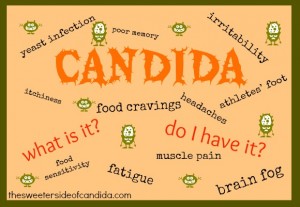What is Candida Yeast Infection
 Key Idea:
Key Idea:
Candida Albicans is a yeast microorganism that commonly lives in the intestinal tract of every human being. It shares space in your bowel with a variety of other microorganisms, mostly helpful bacteria, call probiotics. The bacteria to yeast ration in a healthy person is about 10:1, so in a normal bowel everything lives in a nice ecological balance. The problem comes when your “inner ecology” gets off balance through a variety of causes. The next link (Candida Causes) will discuss these. The bowel becomes vulnerable to other opportunistic’ microorganisms seeking a new home. With no healthy probiotics to keep it under control, the growth of yeast takes off, multiplies and causes Candida Overgrowth yeast infection resulting in a multitude of symptoms.
Overview:
An overgrowth of Candida Albicans is a yeast infection that often begins in the digestive system and gradually spreads to other parts of the body. By the time someone has a vaginal yeast infection, for example, or any other external, surface sign of fungal growth, the yeast has already taken up residence internally.
Dysbiosis:
Dysbiosis includes CO, Irritable Bowel Syndrome (IBS) and Intestinal Permeability (IP or “Leaky Gut”). Dysbiosis means that your inner ecology is out of balance and causing many symptoms. It is important to understand that if you are having symptoms which indicates dysbiosis that the cause may be something other than yeast infection. You could have an overgrowth of bacteria or parasites or Candida yeast. People have come to us convinced that they had CO but in fact did not. Testing revealed something else, for example, bacteria or parasites. This is big reason why we recommend medical testing instead of guessing.
History:
People have been on Earth a long time but Candida Overgrowth is a relatively new problem. CO was rare before World War II. The introduction of the mass use of antibiotics paralleled the rise in yeast infections. Initially a prescription for antibiotics directly preceded almost all yeast infections. In other words, during the 1950’s a yeast infection usually followed a course of antibiotics by a few weeks. By the 1970s women and men began to have yeast infections even when their physicians did not give them a course of antibiotics. Other factors can upset the inner ecology. This is a common problem today.



